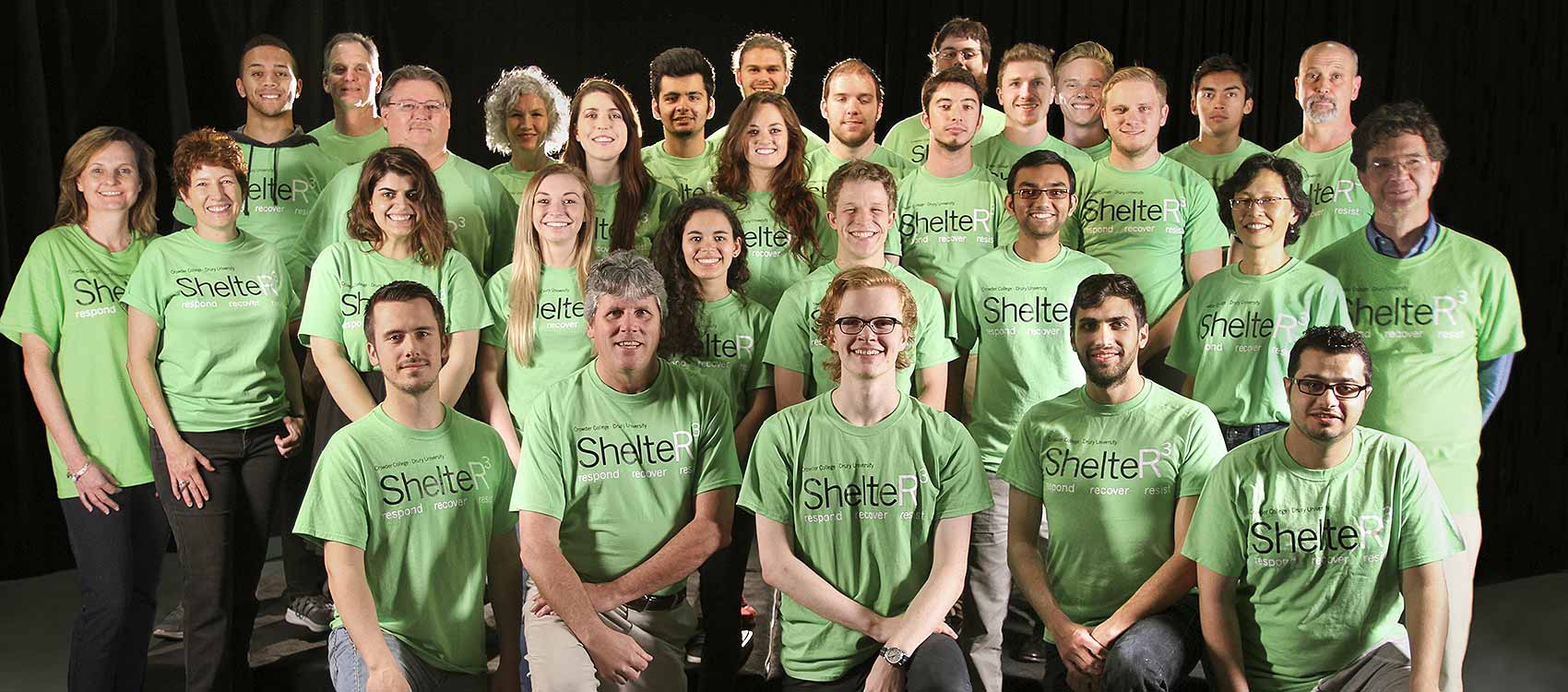
Crowder/Drury: Crowder College and Drury University
ShelteR3, Crowder College and Drury University's U.S. Department of Energy Solar Decathlon 2015 entry, is a disaster-resilient house designed to be both elegantly simple and secure. Its name alludes to the most fundamental purpose of a home—to provide shelter—and the team's design philosophy: Respond, Recover, and Resist. ShelteR3 (pronounced "shelter cubed") will not only accelerate the recovery of those affected by tornadoes but also counter the effects of future disasters.
Crowder College previously competed in Solar Decathlon 2002 and Solar Decathlon 2005. It joined forces with Drury University for the first time in Solar Decathlon 2015.
Design Philosophy
R3—Respond, Recover, Resist—is the guiding philosophy of ShelteR3. In the aftermath of a tornado, ShelteR3 can be quickly transported and installed in two modules. Fully equipped with amenities such as a kitchen, bath, living spaces, and independent power facilities for heating and lighting, it can function as a disaster response command center or disaster relief housing.
ShelteR3's open living area expands to a spacious front porch and semiprivate rear deck. Minimal window openings in the bedrooms, kitchen, and bath create privacy and secure protection. The rooftop solar power system and energy-efficient appliances ensure independent energy. Finally, the ultra-strong core, strengthened by walls of multiple layers of shielding, is further enveloped by an unyielding fence that deflects projectiles in high winds.
Photos
Features
- ShelteR3 can withstand substantial impacts and wind loads, allowing it to resist tornadic storms.
- A multi-layered wall assembly of sheathing, polycarbonate and fiber cement cladding, and an enveloping impact-resistant fence makes the house formidably strong and intelligently elegant.
- The frames and glass of the doors and windows are hurricane-rated.
- An outer set of shielding doors close down in high winds to protect the living area.
Technologies
- A frame of 2-by-6 wood studs spaced at 12 inches on center instead of standard 2-by-4 studs spaced at 16 inches makes the house stronger than traditional houses of similar materials.
- A steel chassis connected by 1/2-inch vertical rods 4 feet on center anchor the roof securely to the foundation to aid in wind resistance.
- The 5/8-inch wall and floor sheathing creates a weather-tight water barrier that is glued and screwed to wood studs at every 3 inches.
- A 14-kW solar energy system uses an array of 36 photovoltaic panels.
Videos
Market Strategy
ShelteR3 is designed for a family of two adults and a child living in a tornado-prone area. Configurable as either easily deployable disaster-relief housing or an expanded, permanent, tornado-resistant home, ShelteR3 can serve three markets: disaster response, relief, and pre-disaster resistance.
What's Next
Joplin, Missouri, was an inspiration for the Crowder/Drury team, and the team hopes ShelteR3 is able to serve the city directly. ShelteR3 serves as a demonstration home, exemplifying sustainable living and embodying disaster resilience in a new green neighborhood. Ideally, the team hopes organizations such as AmeriCorps, the American Red Cross, and FEMA embrace and incorporate the design into disaster response command centers or the mass production of disaster relief housing.
Contact
Traci Sooter
417-873-7416
Neither the United States, nor the Department of Energy, nor the Alliance for Sustainable Energy LLC, nor any of their contractors, subcontractors, or their employees make any warranty, express or implied, or assume any legal liability or responsibility for the accuracy, completeness, or usefulness for any purpose of any technical resources or data attached or otherwise presented here as reference material.
